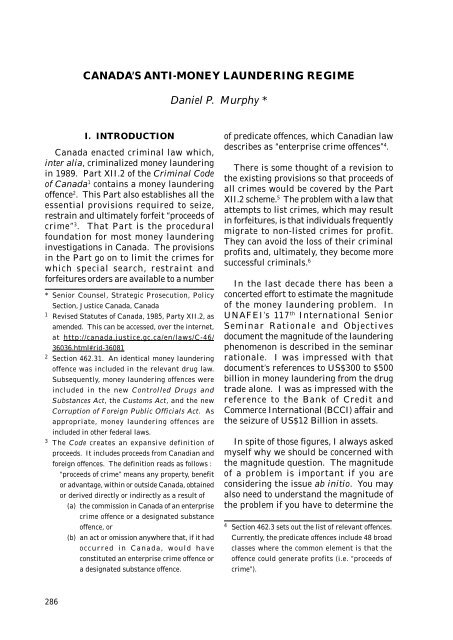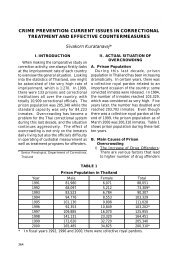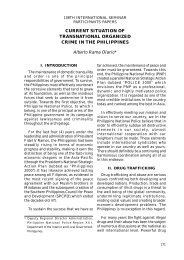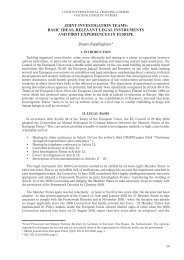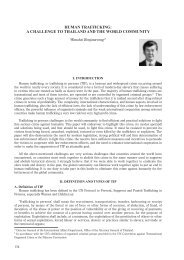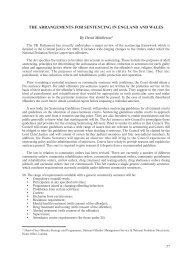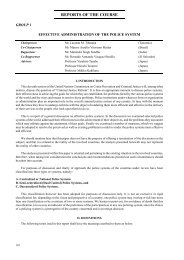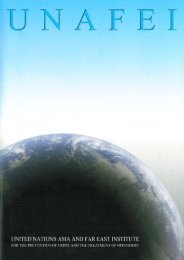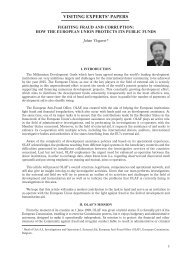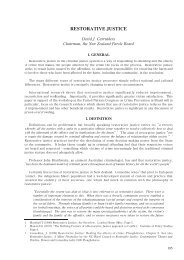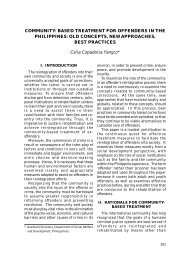CANADA'S ANTI-MONEY LAUNDERING REGIME Daniel P. Murphy *
CANADA'S ANTI-MONEY LAUNDERING REGIME Daniel P. Murphy *
CANADA'S ANTI-MONEY LAUNDERING REGIME Daniel P. Murphy *
You also want an ePaper? Increase the reach of your titles
YUMPU automatically turns print PDFs into web optimized ePapers that Google loves.
117TH INTERNATIONAL SEMINARVISITING EXPERTS’ PAPERSamount of investigative and prosecutionresources you propose to put against theissue. It should not become an overarchingissue since such figures are impossible toprove and as difficult to justify. The simplefact is that criminals launder their profitsof crime to defeat a state’s attempt to seizethose profits. I suggest that the magnitudeissue is less relevant to a betterappreciation of the approaches States cantake to the money laundering problem.Naturally, this assumes that countriesagree that money laundering is a criminaljustice issue.There have been numerous studies onthe harm to national economies and theglobal financial system as a result of moneylaundering. 7 I do not intend to discuss themagnitude of money laundering issue. Itake the phenomenon as a truism and themagnitude issue is less important than theability to investigate and prosecute (civillyor criminally). In Canada’s case we haveelected to investigate and prosecute moneylaundering under our criminal law. 8Criminals will move their criminal profits,abuse the financial system and ignorenational laws because they are criminals.Anyone who sells deadly drugs, illegally,5 The initial impetus for criminal forfeitures, at theinternational level, can be found in the 1988 ViennaConvention against Illicit Traffic in Narcotic Drugsand Psychotropic Substances. Pressure to expandbeyond a drug based attack against criminal profitsdeveloped in the 1985 Milan Plan of Action (i.e. aPlan adopted by the Seventh United NationsCongress on the Prevention of Crime and theTreatment of Offenders) and the 1994 NaplesPolitical Declaration and Global Action Plan. TheNaples meeting was the precursor to the very recentUnited Nations Convention against TransnationalOrganized Crime.The Financial Action Task Force [(see: http://www.oecd.org/fatf/index.htm), an internationalbody that emerged from an initiative of the 1989G7 Summit, as well as the growth of regional FATFtype bodies (such as the Asia/Pacific Group onMoney Laundering (APG) (see: http://www.oecd.org/fatf/Ctry-orgpages/org-apg_en.htm) and theCaribbean Financial Action Task Force (CFATF)(see: http://www.oecd.org/fatf/Ctry-orgpages/orgcfatf_en.htm)]advocated a broadly based moneylaundering provision. This is the clear intent ofthe FATF’s Recommendation 4. It reads as follows:Each country should take such measures as maybe necessary, including legislative ones, to enableit to criminalise money laundering as set forthin the Vienna Convention. Each country shouldextend the offence of drug money laundering toone based on serious offences. Each countrywould determine which serious crimes would bedesignated as money laundering predicate offences.6 In 1892 Canada abolished the common law’shistoric ability to forfeit upon conviction for a felony.The 1892 Code prohibited “any attaindre orcorruption of blood, or any forfeiture or escheat”but it retained the ability to forfeit as part of asentence. Until 1989 forfeitures were reserved tospecified things (e.g. guns, explosives) and offences.The new provisions implemented the 1988 ViennaConventions requirements, expanded the conceptto the listed enterprise crimes and created acriminal offence of money laundering.7 The Basel Committee on Banking Supervision (seehttp://www.bis.org/ ) developed the “Core Principlesfor Effective Banking Supervision” (see: http://www.bis.org/publ/bcbs30a.pdf ). In addition, theBasel Committee’s study on “Prevention of CriminalUse of the Banking System for the purpose of Money-Laundering” (see: http://www.oecd.org/fatf/pdf/basle1988_en.pdf ) illustrates the financialcommunity’s concern with money laundering.Similar concerns can be seen in the securities andinvestment sector (see the InternationalOrganisation of Securities Commissions’ CorePrinciples, at http://risk.ifci.ch/144440.htm), andthe insurance sector, where various principles andstandards of the International Association ofInsurance Supervisors (IAIS) and the OffshoreGroup of Insurance Supervisors consider moneylaundering issues287
RESOURCE MATERIAL SERIES No. 58for profit does not care that they may haveto bribe a banker or corrupt a governmentofficial. That type of activity is a cost ofdoing business. I expect that other expertsat the Seminar will be better able to fullydiscuss the magnitude of the moneylaundering phenomenon. 9 I leave that issueto those experts.The more interesting issue is how acountry approaches money launderingproblems. What are the lessons, if any, ithas learned? What are its roadblocks toeffective money laundering investigationsand prosecutions? How can nationscombine their sovereignties to react tocriminals who use territorial sovereigntyto shelter their profits or hinderinvestigations? These are all validquestions. In this paper I will try andanswer some questions that develop fromCanada’s anti-money laundering regime.In a second discussion I will examine theemerging development of privacy laws,electronic cash and similar issues in theanti-money laundering context.II. INVESTIGATIVE ANDFORFEITURE’S ROLE IN CANADA’SPROCEEDS OF CRIME <strong>REGIME</strong>The 1989 revision to Canada’s CriminalCode built upon earlier work. In 1973 theoffence of possession of property obtainedby crime was added to the Canadian8 On December 5, 2000 the Province of Ontario tabledthe Remedies for Organized Crime and OtherUnlawful Activities Bill, a new civil forfeiture ofproceeds of crime law. (See Bill 155, at http://gateway.ontla.on.ca/library/bills/155371.htm). It isan interesting option but investigative andlitigation results will be the final arbiter of thesuccess of that approach.9 If this assumption is incorrect the FATF publishesreports from its annual money laundering trendsand typologies meetings. (see http://www.oecd.org/fatf/FATDocs_en.htm#Trends)criminal law. 10 The possession offence wasnot generally used. In the early 1980 theRCMP established an anti-drugprofiteering unit to attack the propertyobtained by drug traffickers. They targeteda bank account but the courts ultimatelyoverturned their search warrant. Thatwarrant purported to seize the money heldon deposit in the bank and the court heldthat a warrant could only seize tangibleswhile the money on deposit was anintangible. 11The inability of the police to freeze theassets in the Montreal bank accountcreated added impetus for the subsequentmajor proceeds of crime amendments. ThePart XII.2 scheme created an ability totrace and freeze proceeds of crime at theinvestigative stage, long before chargeswere laid. 12 Once property is seized orretrained further provisions apply to theproperty. The court has jurisdiction toaccept applications to challenge the seizureor restraint orders. A person effected bythe seizure, (i.e. the person in possessionor a person having a valid interest in thething) can seek to overturn the order or,10 S.C., 1972, C.13, s.27. The provision is now foundin subsection 354(1). It creates an offencepunishable by two years, whenever anyonepossesses property obtained from the commissionsof an indictable offence. The subsections states:354. (1) Every one commits an offence who hasin his possession any property or thing orany proceeds of any property or thingknowing that all or part of the property orthing or of the proceeds was obtained by orderived directly or indirectly from(a) the commission in Canada of an offencepunishable by indictment; or(b) an act or omission anywhere that, if ithad occurred in Canada, would haveconstituted an offence punishable byindictment.11 Royal Bank v. Bourque (Sub nom. Quebec A.G. v.Royal Bank) (1985) 18 C.C.C. 98288
117TH INTERNATIONAL SEMINARVISITING EXPERTS’ PAPERSalternatively, seek payments from thetargeted assets to cover reasonable livingbusiness and legal expenses. 13Any proceeds investigation can proceedsimultaneously with the investigation of apredicate offence. It can follow thepredicate offence or it can be a stand-aloneinvestigation. This is because thepossession offence is itself a predicatecharge. The Canadian system is flexible.A criminal could be charged and convictedof the single predicate offence and all of herproceeds of crime could be forfeited. Thisforfeiture must occur at the time ofsentence for the offence. The onus on theprosecutor is to establish that the propertyis proceeds from the offence charged, on abalance of probabilities standard of proof. 14Alternatively, the offender could haveserved their time on the principal chargeand subsequently face a possession ofproceeds of crime charge that allows forforfeiture. They could also be charged witha money laundering offence. In thosescenarios the forfeiture options continue.Independent money launders, not involvedin the underlying offences that gave riseto the proceeds of crime, could also beinvestigated and charged with that offence.Forfeiture is available. In addition,Canadian law, for any drug or organizedcrime offence, provided that “offencerelated property”, sometimes referred to asan instrumentality, can be seized,restrained and subsequently forfeited upon12 Sections 462.32 and 33 of the Criminal Code allowapplications to the court with evidence thatsupports a reasonable belief that the targetedproperty may be forfeited. Subsection 462.35provides that the seizure or restraint is in force forsix months. It is renewed once charges are laidbut it can be extended if the investigation iscontinuing.13 Section 462.3414 Section 462.37(1)conviction.III. <strong>MONEY</strong> <strong>LAUNDERING</strong>,TRANSACTION REPORTING AND AFINANCIAL INTELLIGENCE UNIT,CANADA’S <strong>REGIME</strong>In 1991 Canada enacted a Proceeds ofCrime (money laundering) Act. 15 This Act’sdeclared object, as provided in section 2,specified that:The two referenced sections areCanada’s money laundering offences at thetime the Act was drafted. This object wasaccomplished by a regulatory package 16 .The regulations established financialsector account creation; customeridentification; record keeping; and relatedrecord requirements. The regulations cameinto force on March 26, 1993 and the resultpartially satisfied internationalexpectations. It created a paper trail formoney laundering investigations andprosecutions. It did not oblige effectedbusinesses to actually report suspicioustransactions.There was no specific bank secrecy lawin Canada when the Act became law.Financial institutions and other effectedbusiness could “voluntarily report”suspicious transactions. 17 Subsequentdevelopments resulted in the new Proceeds15 Statutes of Canada 1991,c.26, in R.S.C 1985, C. P-24.5 as amended. (see http://canada2.justice.gc.ca/en/laws/P-24.5/79312.html )“(T)he object of this Act is to establish recordkeepingrequirements in the financial field in orderto facilitate the investigation and prosecution ofoffences under subsection 462.31(1) of the CriminalCode and subsection 9(1) of the Controlled Drugsand Substances Act.16 Proceeds of Crime (Money Laundering) Regulations,as amended, SOR/93-75 (see http://canada2.justice.gc.ca/en/laws/P-24.5/75/145024.html )289
RESOURCE MATERIAL SERIES No. 58of Crime (Money Laundering) Act 18 . Thisnew law is now being implemented over asuitable transition period. Prior toexamining these new provisions it isimportant to consider other legaldevelopments.IV. INCREASED PRIVACYEXPECTATIONSPrivacy expectations of Canadians havesignificantly evolved since 1993 when thefirst Proceeds of Crime (money laundering)Act came into force. The precursor toincreased privacy expectation is seen inconstitutional protections in Canada’s 1984Charter of Rights and Freedoms.17 The common law established an expectation ofconfidentiality between a financial institution andits client. A reporting concept was a voluntaryobligation in light of the confidentiality relationshipbetween a financial institution and its client.Section 462.47 of the Criminal Code (see http://canada.justice.gc.ca/en/laws/C-46/36036.html#rid-36081) developed the voluntary reporting theoryby providing as follows :“For greater certainty but subject to section 241of the Income Tax Act, a person is justified indisclosing to a peace officer or the AttorneyGeneral any facts on the basis of which thatperson reasonably suspects that any property isproceeds of crime or that any person hascommitted or is about to commit an enterprisecrime offence or a designated substance offence.”18 The most important development was thesignificant revision to the FATF’s Recommendation15. Its predecessor called upon States to considera requirement to report suspicious transactions tocompetent authorities. Canada’s voluntaryreporting regime could be said to comply with theearlier recommendation. It did not comply withthe revised recommendation which states, asfollows:15. If financial institutions suspect that fundsstem from a criminal activity, they should berequired to report promptly their suspicions tothe competent authorities.Subsequently, the courts have adopted anexpansive interpretation of an individual’sreasonable expectation of privacy. 19 Thisdevelopment evolved as courts interpretedthe scope of s. 8 of the Charter in variouscases.Concomitantly, privacy expectationsbecame the banner for significant changesas a result of the explosive growth of theInternet and the need to protect electroniccommerce. This led to a new law that hasa direct impact on every business inCanada. The Personal InformationProtection and Electronic Documents Act 20 .It came into force on January 1, 2001. Itspecifically covers banks; other federallyregulated financial institutions; and otherfederal business organizations.Transitional provisions provide that all19 For many years the leading case on bank secrecywas the Tournier v. National Provincial Bank ofEngland, [1924] 1 K.B. 461 (C.A.). See alsoCanadian Imperial Bank of Commerce v. Sayani[1994] 2 W.W.R. 260 (B.C.C.A.). In a 1993 case, R.v. Plant (http://www.canlii.org/ca/cas/scc/1993/1993scc96.html), the Supreme Court of Canadaheld that s. 8 of the Charter protected abiographical core of personal informationmaintained by a commercial enterprise in certainscenarios. In Plant the police obtained hydroconsumption records from a city utility companywithout a search warrant. Justice Sopinka, for themajority, opined on the issue of access to commercialinformation as follows :“The United States Supreme Court has limitedapplication of the Fourth Amendment (the rightagainst unreasonable search and seizure)protection afforded by the United StatesConstitution to situations in which theinformation sought by state authorities ispersonal and confidential in nature: UnitedStates v. Miller, 425 U.S. 435 (1976). That casedetermined that the accused’s cheques,subpoenaed for evidence from a commercial bank,were not subject to Fourth Amendmentprotection. While I do not wish to be taken290
RESOURCE MATERIAL SERIES No. 58light of Canada’s constitutional frameworkand its Charter. Our Charter normallyrequires a prior judicial authorizationbefore an agent of the state, such as thenew Centre, obtains information. 23 Thishad a significant impact upon the draftersas the new law developed. The RCMP, asa law enforcement agency, could not hostthe Centre without creating a Charter risk.Essentially, if a law enforcement agency,directly or through a subsidiary part of theenforcement agency, obtained personalinformation without a warrant. It operatesunder a significant section 8 Charter risk.The solution was to establish a newindependent agency.This new Centre was deliberatelyestablished without investigative powers.The law also placed significant restrictionson the amount of data that the Centre coulddivulge to investigators. 24 Otherwise, theCentre’s information collection activityactivities would be challenged. Itsauthority to collect suspicious or proscribedtransaction reports may have been seen asa backdoor device for law enforcement. TheCharter required law enforcement to usesearch warrants and similar priorauthorizations. The new Centre was adeliberate choice in the Proceeds of Crime(Money Laundering) Act as a suitablecompromise to undertake a regulatory andanalysis function, rather than a lawenforcement function.When fully implemented, the Act repealsits predecessor. Structurally, the Actconsists of five parts. Part I containsspecific objects 25 which define the purposesfor the legislation. This Part obliges adesignated business to make and maintainrecords; report either questionable (i.e.suspicious) or prescribed financialtransactions 26 to the new Centre. Therecord keeping and maintenance provisionswill continue to facilitate an investigativepaper trail. Law enforcement will have to22 This is best seen in the work of the Egmont Group.)23 The seminal Supreme Court of Canada’s decisionon point is R. v. Hunter and Southam [1984] 2 S.C.R14524 Section 55 first states that the Centre may notdisclose the information it collects, other than underthe provisions set out in subsection 55(3), (4) and(5). Those subsections provide, as follows :(3) If the Centre, on the basis of its analysis andassessment under paragraph 54(c), hasreasonable grounds to suspect that designatedinformation would be relevant to investigatingor prosecuting a money laundering offence, theCentre shall disclose the information to(a) the appropriate police force;(b) the Canada Customs and Revenue Agency,if the Centre also determines that theinformation is relevant to an offence ofevading or attempting to evade paying taxesor duties imposed under an Act ofParliament administered by the Minister ofNational Revenue;(c) the Canadian Security Intelligence Service,if the Centre also determines that theinformation is relevant to threats to thesecurity of Canada within the meaning ofsection 2 of the Canadian SecurityIntelligence Service Act; and(d) the Department of Citizenship andImmigration, if the Centre also determinesthat the information would promote theobjective set out in paragraph 3(j) of theImmigration Act and is relevant todetermining whether a person is a persondescribed in subsection 19(1) or (2) or section27 of that Act or to an offence under section94.1, 94.2, 94.4, 94.5 or 94.6 of that Act.(4) The Centre may disclose designatedinformation to an institution or agency of aforeign state or of an international organizationestablished by the governments of foreign statesthat has powers and duties similar to those ofthe Centre if(a) the Centre has reasonable grounds to292
117TH INTERNATIONAL SEMINARVISITING EXPERTS’ PAPERSuse search warrants or voluntarydisclosures to access that trail. On theother hand, the Centre will have significantfinancial information for its purposesPart II creates cross border currency andmonetary instrument reportingobligations. Persons must report toCanada’s Customs and Revenue Agency 27 .Persons will be obliged to report theimportation or exportation of proscribedcurrency or monetary instruments. PartIII establishes the Centre to collect,analyse, assess and disclose designatedinformation in order to assist in thedetection, prevention and deterrence ofsuspect that the information would berelevant to the investigation or prosecutionof a money laundering offence or asubstantially similar offence; and(b) the Minister has, in accordance withsubsection 56(1), entered into an agreementor arrangement with that foreign state orinternational organization regarding theexchange of such information.(5) The Centre may disclose designatedinformation to an institution or agency of aforeign state that has powers and duties similarto those of the Centre if(a) the Centre has reasonable grounds tosuspect that the information would berelevant to the investigation or prosecutionof a money laundering offence or asubstantially similar offence; and(b) the Centre has, in accordance withsubsection 56(2), entered into an agreementor arrangement with that institution oragency regarding the exchange of suchinformation.25 The objects are found in s. 3 and state :The object of this Act is(a) to implement specific measures to detect anddeter money laundering and to facilitate theinvestigation and prosecution of moneylaundering offences, including(i) establishing record keeping and clientidentification requirements for financialservices providers and other persons thatengage in businesses, professions or activitiesthat are susceptible to being used for moneylaundering,(ii) requiring the reporting of suspiciousfinancial transactions and of cross-bordermovements of currency and monetaryinstruments, and(iii) establishing an agency that is responsiblefor dealing with reported and otherinformation;(b) to respond to the threat posed by organizedcrime by providing law enforcement officials withthe information they need to deprive criminalsof the proceeds of their criminal activities, whileensuring that appropriate safeguards are put inplace to protect the privacy of persons withrespect to personal information aboutthemselves; and(c) to assist in fulfilling Canada’s internationalcommitments to participate in the fight againsttransnational crime, particularly moneylaundering.26 Two sections are relevant. The first, section 7, dealswith suspicious transaction reporting; the second,section 9, deals with proscribed transactionreporting. Section 7 provides, as follows:7. In addition to the requirements referred to insubsection 9(1), every person or entity shallreport to the Centre, in the prescribed form andmanner, every financial transaction that occursin the course of their activities and in respect ofwhich there are reasonable grounds to suspectthat the transaction is related to the commissionof a money laundering offence.:Section 9 provides for proscribed transactionreporting, as follows:9. (1) Every person or entity shall report to theCentre, in the prescribed form and manner, everyprescribed financial transaction that occurs inthe course of their activities.The Act specifies that something is proscribed byregulations. Therefore, the subsequent regulatorypackage will establish when specific transactions,293
RESOURCE MATERIAL SERIES No. 58laundering the proceeds of crime. TheCentre is also responsible for ensuringcompliance with Part I of the Act. Part IVauthorises the Governor in Council to makeregulations. Part V creates offences,including the failure to report suspiciousfinancial transactions and the prohibiteduse of information under the control of theCentre. 28VI. CURRENT <strong>MONEY</strong><strong>LAUNDERING</strong> INVESTIGATIVESITUATION IN CANADAThe Royal Canadian Mounted Police(RCMP), within its federal policingportfolio, operate the national proceeds ofcrime programme. 29 They have developedthirteen Integrated Proceeds of Crime(IPOC) Units tasked with investigativeresponsibility for proceeds of crime. Theseunits include peace officers (RCMPmembers and seconded officers from localas opposed to suspicious transactions, will have tobe reported to the Centre.27 This will comply with the FATF’s Recommendations22. The Act establishes a cross border reportingregime as follows:12. (1) Every person or entity referred to insubsection (3) shall report to an officer, inaccordance with the regulations, the importationor exportation of currency or monetaryinstruments of a value greater than theprescribed amount.(2) A person or entity is not required to make areport under subsection (1) in respect of anactivity if the prescribed conditions are met inrespect of the person, entity or activity, and ifthe person or entity satisfies an officer that thoseconditions have been met.(3) Currency or monetary instruments shall bereported under subsection (1)(a) in the case of currency or monetaryinstruments in the actual possession of aperson arriving in or departing from Canada,orthat form part of their baggage if they and theirbaggage are being carried on board the sameconveyance, by that person;(b) in the case of currency or monetaryinstruments imported into Canada by courieror as mail, by the exporter of the currency ormonetary instruments or, on receiving noticeunder subsection 14(2), by the importer;(c) in the case of currency or monetaryinstruments exported from Canada by courieror as mail, by the exporter of the currency ormonetary instruments;(d) in the case of currency or monetaryinstruments, other than those referred to inparagraph (a) or imported or exported as mail,that are on board a conveyance arriving in ordeparting from Canada, by the person incharge of the conveyance; and(e) in any other case, by the person on whosebehalf the currency or monetary instrumentsare imported or exported.(4) If a report is made in respect of currency ormonetary instruments, the person arriving in ordeparting from Canada with the currency ormonetary instruments shall(a) answer truthfully any questions that theofficer asks with respect to the informationrequired to be contained in the report; and(b) on request of an officer, present the currencyor monetary instruments that they arecarrying or transporting, unload anyconveyance or part of a conveyance or baggageand open or unpack any package or containerthat the officer wishes to examine.(5) Officers shall send the reports they receiveunder subsection (1) to the Centre.Once again, the regulations will flesh out thereporting requirements.28 Sections 74 to 80 of the Act create a number ofoffences where persons or entities (e.g.corporations) criminally fail to comply with the Act.The penalties vary with the relevant offences butthey include incarceration for up to five years andfines up to $2 million dollars.294
117TH INTERNATIONAL SEMINARVISITING EXPERTS’ PAPERSpolice departments), tax and customsofficers, forensic accountants, and legalcounsel (i.e. prosecutors and advisors). Inaddition the Federal Prosecution Service,the prosecution arm of the CanadianDepartment of Justice, has thirteenregional offices and branch offices oragents, throughout Canada, who routinelyprosecute proceeds of crime casesinvestigated by the RCMP and the majorpolice forces in Canada.It should also be appreciated that thereis only one source for criminal law inCanada. The federal government has thesole authority to enact criminal law andlaws of criminal procedure. This is whyPart XII.2 of the Criminal Code applies toany proceeds of crime criminalinvestigation and prosecution.Various prosecutors can undertakecriminal prosecutions. Federalprosecutions routinely involve non-Criminal Code money launderingprosecutions, unless a provincial AttorneyGeneral agrees that a federal prosecutioncan include a Code “enterprise crimeoffence”. 30 On the other hand, provincialAttorneys General and local lawenforcement can investigate and enforcethe criminal law in Canada. The dualability of federal and provincial AttorneysGeneral to prosecute is a novel feature ofthe Canadian criminal justice system.29 The RCMP acts as a contract police force for all buttwo provinces (Ontario and Quebec). It also is asignificant player in many municipal policecontracts. It is the major proceeds of crimeinvestigative authority in Canada. You can accessfurther information on this particular aspect oftheir work on the Internet, at http://www.rcmpgrc.gc.ca/frames/rcmp-grc1.htm. The RCMPcurrently maintains thirteen Integrated Proceedsof Crime (IPOC) units across Canada in the majorcities and regions.VII. CANADA’S APPROACH TOCRIMINAL ORGANIZATIONSRecently, the money laundering debatehas been intermixed with the issue oftransnational organized criminal groups.Canada has joined in that debate. Therewas a very recent significant modificationto the Canadian criminal law. In 1996 thepublic’s perception of a problem withcriminal organisations resulted in asignificant expansion of the criminal lawand investigative powers in Canada. 31 TheRCMP re-focused investigative priorities todeal with the organized crime issue. Theirearlier approach to proceeds of crimeinvestigations has now become anintegrated approach where proceeds andcriminal organizations are dealt with intandem 32 .The two issues are easily related. Anyeffective attack against organized crimemust consider the profits from that crime.Canada and the various Provincialgovernments have collectively undertakenan expanded organized crime programmeas a national initiative. It is primarilydirected against organizations that areinvolved in a violent turf war (e.g. outlawmotorcycle gangs) and others involved intransnational organized crime. Obviously,30 Section 2 of the Criminal Code defines and controlsthe case prosecutor in Canada. Broadly speakinganyone can institute most criminal charges andprosecute a case. The Code allows the AttorneyGeneral, as defined in s. 2, to intervene and takeover a private prosecution. In addition, only counselfor the Attorney General can make various proceedsof crime applications, such as applications forspecial search warrants and restraint ordersagainst proceeds of crime and all forfeitureapplications. It is therefore important to ascertainwhich Attorney General is conducting aprosecution. Equally, any forfeiture goes to theAttorney General who made the forfeitureapplication. (See s. 462.37 of the Code)295
RESOURCE MATERIAL SERIES No. 58this initiative targets groups of individuals.After all, an organization, by definition,must include five or more persons. Thiscreates increased investigative costs andsystemic issues for the criminal justicesystem 33 .There are proceeds of crime and moneylaundering ramifications in any criminalorganization investigation. Collectively,the organization should realise morecriminal activity. A criminal organizationtargets profitable crimes. This justifiesmore intensive investigative resources.Does this mean that states should onlyconcentrate on organizations? I believethat such a decision would be a mistake.31 Section 467.1 created a new participation in acriminal organization offence with a maximumpunishment of fourteen years. Section 2 of the Codedefined a criminal organization in the followingmanner :“criminal organization” means any group,association or other body consisting of five ormore persons, whether formally or informallyorganized,(a) having as one of its primary activities thecommission of an indictable offence under thisor any other Act of Parliament for which themaximum punishment is imprisonment for fiveyears or more, and(b) any or all of the members of which engage inor have, within the preceding five years, engagedin the commission of a series of such offences;The Code’s wiretap provisions were also modified(e.g. A one year wiretap authorization could beobtained) and other related amendments weremade.32 In February 2000 the RCMP announced a majornew organized crime initiative. See http://www.rcmp-grc.gc.ca/frames/rcmp-grc1.htm.33 The system must adapt to larger trials. Theevidence is much more complex. Year long wiretapinvestigations, multiple defendants and increasedlegal aid costs are some of the problems in thisinitiative.Any organized criminal or criminalorganization, and I intentionallydistinguish between the two concepts,launders to protect their profits. Theactivity of either requires that criminalprofits be laundered. Any moneylaundering has a serious negative effectupon financial systems. It involves thesame issues and creates demands for thesame limited investigative resources. Theindividual “organized” criminal andcriminal organizations, in general equallyharm societal interests. The scale of thecriminal activities and profits is the onlysignificant difference.The fact is criminal profits can be usedto buy financial and other advice. Theinternational financial system is availablefor a rich individual criminal or a criminalorganization. Either type of criminal mustuse the same techniques to launder theircriminal profits. Indeed, with the evolutionof the global financial system, anycriminal’s laundering difficulties are easier.Apart from exceptional investigativeauthority 34 available in a criminalorganization offence, the investigativeeffort is the same.The problem is that criminalorganizations are merging to takeadvantage of expertise available in anotherorganization. Why compete when a mergedorganization is more efficient? The mergedgroups work off each other’s strengths.They do not compete for the media’sattention. They do not have to worry whatthey next year’s budget allocation will beand how their manpower needs will beresolved. The reality is that organizedcrime groups are sometimes more efficient34 Section 186.1 of the Criminal Code permits a oneyear wiretap authorization when the underlyinginvestigation is committed for the benefit of, at thedirection of or in association with a criminalorganization.296
117TH INTERNATIONAL SEMINARVISITING EXPERTS’ PAPERSthan law enforcement. National selfinterestand laws are irrelevant to acriminal organization!In order that nations respond to thisreality their law enforcement agenciesmust do their investigations moreeffectively. States and law enforcementmust co-operate or recognise that criminalorganizations will continue on the basisthat laws and the police are minorinconveniences. This means that newforms of international co-operation must bedeveloped. Time and space restraints limita discussion of this issue.I can raise at least one investigativetechnique to illustrate this fact. Moneylaundering creates a need to develop proactiveinvestigative techniques. The policecan not wait at their station for aremorseful criminal to walk in andconfess 35 . One effective technique can beseen in a law enforcement storefrontoperation. Does a storefront moneylaundering operation offer the police aproblem free effective alternativeinvestigative technique?35 R. v. Bond, 135 A.R. 329 (Alberta C.A.) at page 333opinedIllegal conduct by the police during aninvestigation, while wholly relevant to the issue ofabuse of the court’s processes, is not per se fatal toprosecutions which may follow: Mack, supra, at 558.Frequently it will be, but situational police illegalityhappens. Police involve themselves in high speedchases, travelling beyond posted speed limits.Police pose as prostitutes and communicate for thatpurpose in order to gather evidence. Police buy,possess, and transport illegal drugs on a daily basisduring undercover operations. In a perfect worldthis would not be necessary but, patently, illegaldrug commerce is neither successfully investigated,nor resisted, by uniformed police peering throughhotel-room transoms and keyholes or waitingpatiently at police headquarters to receive theconfessions of penitent drug-traffickers :VIII. <strong>MONEY</strong> <strong>LAUNDERING</strong>INVESTIGATIVE TECHNIQUESAND THE RULE OF LAWLaw enforcement can undertake astorefront money laundering operationwhere the police and co-operating agentshold themselves out as service providersfor criminals. This type of investigativetechnique has advantages and problems.The police must conceal and convertcriminal assets in this type of operation.That is the essence of a money launderingoperation. The police view the operationfrom a different perspective. They movemoney or other assets to record thecriminal’s instructions and gather evidencefor subsequent prosecutions. If someonereviews the law enforcement activity froma justice policy viewpoint the investigatorsmay have a good motive but they arecommitting crimes. Are they any betterthan the criminals? Some consider thisissue through he eyes of law enforcementothers argue that the rule of law shouldapply to the police and the criminals alike.A. Police IllegalityThe Supreme Court of Canadaconsidered the police illegality issue in apolice reverses sting drug investigation. InR. v. Campbell and Shirose 36 , the court heldthat the police were not immune fromcriminal liability for criminal activitiescommitted in the course of a bona fidecriminal investigation. However, whileobserving that “everybody is subject to theordinary law of the land”, the SupremeCourt explicitly recognised that “if someform of public interest immunity is to beextended to the police...it should be left toParliament to delineate the nature and36 This and other Supreme Court decisions can befound at : http://www.scc-csc.gc.ca/Judgments_Jugements/menu_e.htm. . R. v.Campbell and Shirose can be accessed at http://www.canlii.org/ca/cas/scc/1999/1999scc18.html.297
RESOURCE MATERIAL SERIES No. 58scope of the immunity and thecircumstances in which it is available”. TheCourt noted further that “in this countryit is accepted that it is for Parliament todetermine when in the context of lawenforcement the end justifies the meansthat would otherwise be unlawful”. Thismeans that the law must keep up withcriminal activity and address the needs ofproactive law enforcement. That is adifficult requirement in any democracy.B. Benefits in a StorefrontOperationThe use of storefront money launderingtechniques has been proven to be veryeffective. The technique has severaladvantages. Criminals come to theundercover police operation rather than thepolice attempting to infiltrate a criminal’sorganization. Criminals, once satisfiedthat the storefront money launderingoperation can deliver, frequently divulgeinformation. Often that is information thatlaw enforcement would never discover intheir ordinary investigations. Essentially,criminals brag about their criminalprowess. Their admissions provideinvaluable criminal intelligence. As amoney laundering service, the storefrontallows law enforcement to better track theassets moved by the undercover operatives.The storefront client can tell theundercover operative where they want theasset to go, or better yet, the undercoveroperative can suggest alternative routesand investments. In either scenario thelong-term goal is to track, trace, freeze andultimately, forfeit the assets.C. Associated Problems in aStorefront OperationStorefront money laundering operationsalso create problems. Frequently thelaundered assets must be moved offshore.Obviously, foreign law enforcement mustco-operate in these investigations.Otherwise a domestic investigation thatmoves outside Canada runs the risk ofinfringing another State’s law. Theseoperations must be long term. The up-frontdevelopment costs would be easilyfrustrated if the police immediatelyarrested the first criminal that brought ina suitcase of cash to be laundered. Thereis a continuous risk that the storefront’slaundered cash could be used to purchasemore drugs or foster other criminal activity.This is a difficult reality to deal with assome point in every storefrontinvestigation.D. A Police Officer Exception to theMoney Laundering OffenceIn Canada we have a concern with illegalpolice conduct. The undercover policeofficer must inevitably commit a moneylaundering offence. The police are subjectto the rule of law. Laundering is a broadlydefined concept in Canada’s criminal law. 37The offence provisions are broad enoughto include the controlled delivery of assetsthat the police know or believe are proceedsof crime. Essentially, the scope of thesection could be seen to resemble controlleddeliveries of drugs. 38 The important pointto remember is that the “rule of law”37 Section 462.31 (1) provides as follows :Every one commits an offence who uses, transfersthe possession of, sends or delivers to any personor place, transports, transmits, alters, disposesof or otherwise deals with, in any manner andby any means, any property or any proceeds ofany property with intent to conceal or convertthat property or those proceeds, knowing orbelieving that all or a part of that property or ofthose proceeds was obtained or derived directlyor indirectly as a result of(a) the commission in Canada of an enterprisecrime offence or a designated substanceoffence; or(b) an act or omission anywhere that, if it hadoccurred in Canada, would have constitutedan enterprise crime offence or a designatedsubstance offence.298
117TH INTERNATIONAL SEMINARVISITING EXPERTS’ PAPERSapplies. If the police commit an unlawfulact in their investigation the defence willargue that their illegal activity taints theinvestigation and justifies a judicial “stayof proceedings”.Parliament, to use the words of theSupreme Court, in R. v. Campbell andShirose, delineated “the nature and scopeof the immunity and the circumstances inwhich it is available”. This occurred as aresult of a statutory money launderingexception for law enforcement. 3938 The 1988 Vienna Convention specifically calls uponcountries to co-operate in controlled deliveries ofdrugs. In 1996 Canada’s new Controlled Drugs andSubstances Act’s (CDSA) new Controlled Drugs andSubstances Act (Police Enforcement) Regulations,SOR/97-234 (see http://canada2.justice.gc.ca/en/laws/C-38.8/234/67999.html ) established a veryrigorous administrative regime for state supplieddrugs and exceptions for law enforcement whenthey undertake investigations that could infringethe CDSA offences.39 Subsection 462.31(3) of the Criminal Code, as wellas identical amendments in other moneylaundering offences, provides as follows :(3) A peace officer or a person acting under thedirection of a peace officer is not guilty of anoffence under subsection (1) if the peace officeror person does any of the things mentioned inthat subsection for the purposes of aninvestigation or otherwise in the execution ofthe peace officer’s dutiesThis is not a wide-open exception for any peaceofficer. For example foreign law enforcement officialwould not be considered to be a peace officer inCanada. That foreign law enforcement officer orany civilian agent assisting a peace officer mustact under the direction and control of a peace officer.In addition the peace officer must be undertakingthe money laundering investigation as part of his/her duties.It should be noted that the mereexistence of a law enforcement exceptiondoes not mean that the storefront moneylaundering operation’s client has nodefences. The exception operates as ashield for law enforcement and personsacting under the direction and control ofthe peace officer but it does not obviate anydefence for the accused individual.Entrapment continues to be a recognisedlegal defence in Canada 40 .40 In 1985, in R. v Jewitt [1985] 2 S.C.R. 128, 136-137, the Supreme Court of Canada found thatcourts had a discretion, although it could only beexercised in “the clearest of cases”. Subsequentdecisions from the court have expanded upon theconcept. Madam Justice L’Heureux-Dub_ has beenquite instrumental in developing the law in thisarea. In R. v. Conway, [1989] 1 S.C.R. 1659, 1667she said that:“ ... where the affront to fair play and decency isdisproportionate to the societal interest in theeffective prosecution of criminal cases, then theadministration of justice is best served by stayingthe proceedings.”In Power [1994] 1 S.C.R. 601, she defined “theclearest of cases” to mean “conduct which shocksthe conscience of the community.” She said thecases of this nature will be extremely rare. InO’Connor [1995] 4 S.C.R. 411, 465, she said a staywill only be appropriate when two criteria arefulfilled:1. Where the prejudice caused by the abuse inquestion will be manifested, perpetuated oraggravated through the conduct of the trial,or by its outcome (in other words, this is not aremedy for past misconduct per se; there hasto be some continuing abuse); and2. Where no other remedy is reasonably capableof removing that prejudice.Finally, R. v. Mack, [1988] 2 S.C.R 903 is theseminal decision on point. It fully canvassed allaspects of the issue and raised the problem causedby police illegality.299
RESOURCE MATERIAL SERIES No. 58E. Storefront OperationImplementation IssuesIn the last decade the RCMP hasundertaken a number of storefront moneylaundering operations. They have alsoassisted foreign law enforcement in moneypick ups and ancillary activity. Theexistence of the law enforcement exceptionhas assisted the police as they determineif a proposed storefront or other proactiveinvestigative technique is appropriate. Inspite of this exception, every storefrontmoney laundering proposal creates othersignificant issues.Some issues are obvious. Theseoperations became security problems.Generally, the undercover team deals withsignificant amounts of cash. Properpersonal and exhibit security is required.Cover teams; safe locales; and recordkeeping systems are essential. Storefrontenforcement cases also have otherunexpected surveillance costs.F. One-party InterceptionsEvery case commences with theexpectation that the best admissibleevidence is sought. Frequently, thisrequires the interceptions of theparticipant’s conversations and videosurveillance of their conduct. This isrequired for the personal security of theoperatives. Equally, interception evidenceis important for the intrinsic value of theevidence obtained by means of theinterception. The problem is thatCanadian interception law creates preconditionsthat all investigativeparticipants in a storefront operationshould understand.Electronic surveillance evidence isadmissible against an accused person, inCanada, provided that the evidence waslawfully obtained. Canadian law 41 providesthat a judicially authorised one-partyconsent interception order can and shouldbe obtained in all cases. This is importantconsideration in any Canadian storefrontlaundering case. A Canadian peace officermust work on the case so that the officerand others are sheltered within theexception created by ss. 463.31. Anyundercover operation will use a Canadianpeace officer. Every foreign peace officer,posing as an agent, or civilian argent, mustoperate under the Canadian peace officer’sdirection and control to shelter under theexception. They are agents of the state forinterception purposes. This has an impacton any possible interception.These operations frequently include aninternational dimension has an effect oninterception options. Canada’s CriminalCode, and, in particular, Part VI does notapply outside Canada. This means thatinterceptions of private communicationsoutside Canada must comply with the lawin the territory upon which the interceptionoccurred. Charter considerations maycontinue to apply 42 in some cases. The bestadvise is to obtain judicial authorisationswhenever possible.41 Part VI of the Criminal Code governs. (See http://canada.justice.gc.ca/en/laws/C-46/35184.html). Theinterception of private communications by an‹‹agent of the state›› with the consent of one of theparticipants but without prior judicialauthorization violates s. 8 of Canada’s Charter ofRights and Freedoms. The Supreme Court ofCanada, in R. v. Duarte, refused to apply Americanjurisprudence and opined that while a s. 184criminal offence did not occur in a one party consentinterception scenario that in all cases where stateagents consented a prior judicial authorization wasa constitutional prerequisite. (see : http://www.canlii.org/ca/cas/scc/1990/1990scc2.html ). Asa result subsections 184.1 to 184.4 were added toPart VI of the Code.42 Section 8 of the Charter gives persons “the right tobe secure against unreasonable search and seizure”.Case law indicates that the Charter may applyoutside Canada in certain cases.300
117TH INTERNATIONAL SEMINARVISITING EXPERTS’ PAPERSG. Other Investigative ConductUndercover investigations are a routinefeature in Canadian law enforcement.Apart from the one-party intercept scenarioundercover operatives have few legalroadblocks to control their activity.Recently, the defence bar has seized uponthe R. v. Campbell and Shirose and itspredecessors to successfully argue that anypolice illegality taints an investigation andinures to the benefit of the criminaldefendant.The tainted police conduct shocks thecommunity’s standards of fairness. Theargument is that this conduct requires thecourt to enter a stay of proceedings. Thishas been argued in several cases. Mostoccurred before the recent amendment to462.31 creating a law enforcementexception. 43 The money launderingexception does not create exceptions forother unlawful conduct. The defencefrequently looks for unlawful activity toadvance a defence. Therefor investigatorsmust be aware of this concern.H. Profits or EvidenceFinally, what happens to the profits froma Canadian storefront money launderinginvestigation? Canada’s financialadministration provisions and the criminallaw 44 have another unexpected impactupon storefront money launderingoperations. The storefront operatorcharges the criminal for their investmentor cash conversion activity. If they did notthe criminal would be suspicious. Lawenforcement would like to re-invest thesecharges into the operation to help fund thestorefront’s costs. This is a problem.The realities are that the operation
States seem prone to an approach thatsuggests co-operation while investigatorscompete for budgets and media attention.The Attorney General of Trinidad andTobago advised the InternationalAssociation of Prosecutors, in a speech atOttawa, in September 1998, that nationshad to pool their sovereignties to protecttheir sovereignties. Free trade and theeasy movement of capital and informationmerely accelerates the need to actuallyadopt the Attorney General’s observation.RESOURCE MATERIAL SERIES No. 58302


